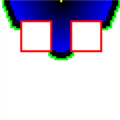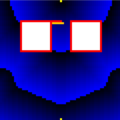Operation
The basic operation of D* is outlined below.
Like Dijkstra's algorithm and A*, D* maintains a list of nodes to be evaluated, known as the "OPEN list". Nodes are marked as having one of several states:
- NEW, meaning it has never been placed on the OPEN list
- OPEN, meaning it is currently on the OPEN list
- CLOSED, meaning it is no longer on the OPEN list
- RAISE, indicating its cost is higher than the last time it was on the OPEN list
- LOWER, indicating its cost is lower than the last time it was on the OPEN list
Expansion
The algorithm works by iteratively selecting a node from the OPEN list and evaluating it. It then propagates the node's changes to all of the neighboring nodes and places them on the OPEN list. This propagation process is termed "expansion". In contrast to canonical A*, which follows the path from start to finish, D* begins by searching backwards from the goal node. This means that the algorithm is actually computing the A* optimal path for every possible start node. [10] Each expanded node has a back pointer which refers to the next node leading to the target, and each node knows the exact cost to the target. When the start node is the next node to be expanded, the algorithm is done, and the path to the goal can be found by simply following the back pointers.
- Expansion in progress. The finish node (yellow) is in the middle of the top row of points, the start node is in the middle of the bottom row. Red indicates an obstacle; black/blue indicates expanded nodes (brightness indicating cost). Green indicates nodes which are being expanded.
- Expansion finished. The path is indicated in cyan.
Obstacle handling
When an obstruction is detected along the intended path, all the points that are affected are again placed on the OPEN list, this time marked RAISE. Before a RAISED node increases in cost, however, the algorithm checks its neighbors and examines whether it can reduce the node's cost. If not, the RAISE state is propagated to all of the nodes' descendants, that is, nodes which have back pointers to it. These nodes are then evaluated, and the RAISE state is passed on, forming a wave. When a RAISED node can be reduced, its back pointer is updated, and passes the LOWER state to its neighbors. These waves of RAISE and LOWER states are the heart of D*.
By this point, a whole series of other points are prevented from being "touched" by the waves. The algorithm has therefore only worked on the points which are affected by change of cost.
- An obstacle has been added (red) and nodes marked RAISE (yellow).
- Expansion in progress. Yellow indicates nodes marked RAISE, green indicates nodes marked LOWER.
Another deadlock occurs
This time, the deadlock cannot be bypassed so elegantly. None of the points can find a new route via a neighbor to the destination. Therefore, they continue to propagate their cost increase. Only points outside of the channel can be found, which can lead to destination via a viable route. This is how two Lower waves develop, which expand as points marked as unattainable with new route information.
- Channel blocked by additional obstacles (red)
- Expansion in progress (Raise wave in yellow, Lower wave in green)
- New path found (cyan)






